Key takeaways:
- Street art photography interprets the stories behind urban artworks, creating a dialogue between artists, observers, and photographers.
- Choosing the right equipment, such as a lightweight mirrorless camera and a fast prime lens, enhances the quality of street art photographs.
- Engaging with street artists enriches the photographic experience, offering insights and narratives that transform the art into a deeper story.
- Effective composition and editing techniques, like proper framing and color enhancement, are crucial for capturing and conveying the essence of street art.
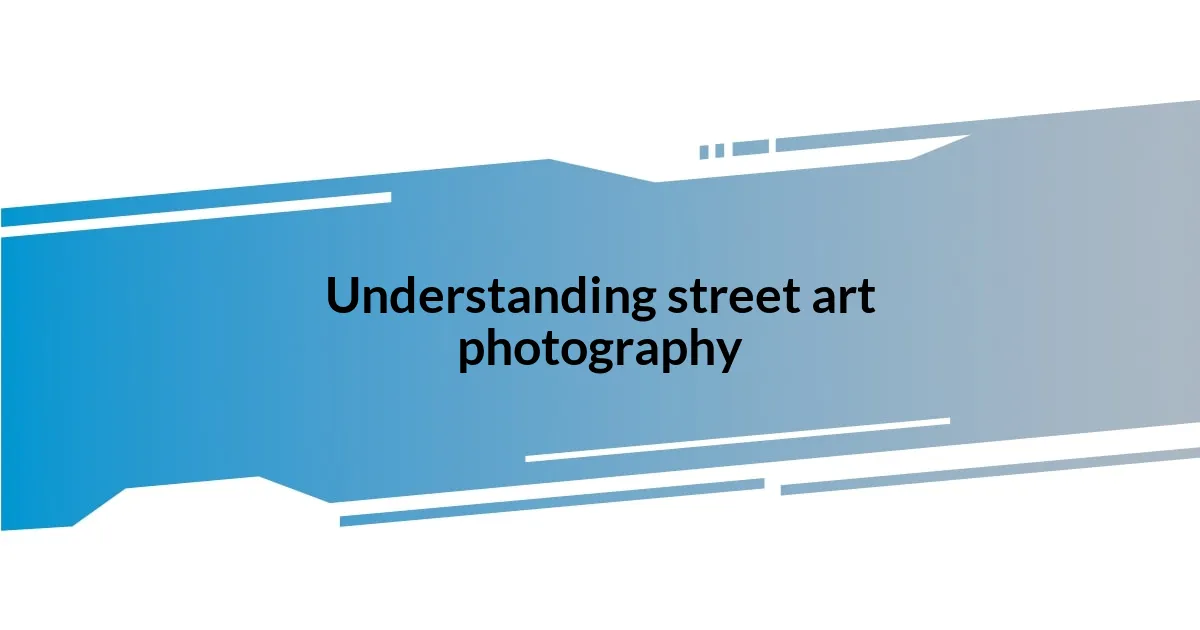
Understanding street art photography
Street art photography is not just about capturing images; it’s about interpreting the stories behind those vibrant murals and stickers that adorn our urban landscapes. I remember my first encounter with a striking piece in a forgotten alleyway—it felt like the art was whispering secrets of the city to me. Have you ever stood before a piece of art and felt an instant connection? That’s the magic of street art; it evokes emotions and thoughts that challenge our perceptions of public spaces.
What excites me about this genre is the blend of spontaneity and creativity. Each photograph I take serves as a point in time, encapsulating not only the artwork but also the mood of the environment around it. There’s a certain thrill in finding a hidden gem and knowing that no one else might ever see it in the same light. I often ask myself: how does the context of the location change the message of the art?
In essence, street art photography is a dialogue between the artist and the observer, with the photographer acting as the bridge. Each shot holds a piece of the artist’s intent and the viewer’s interpretation. My experiences tell me that when I pause and truly engage with a mural, the photograph transforms into a narrative that speaks to anyone who views it, inviting them to discover their own meaning.
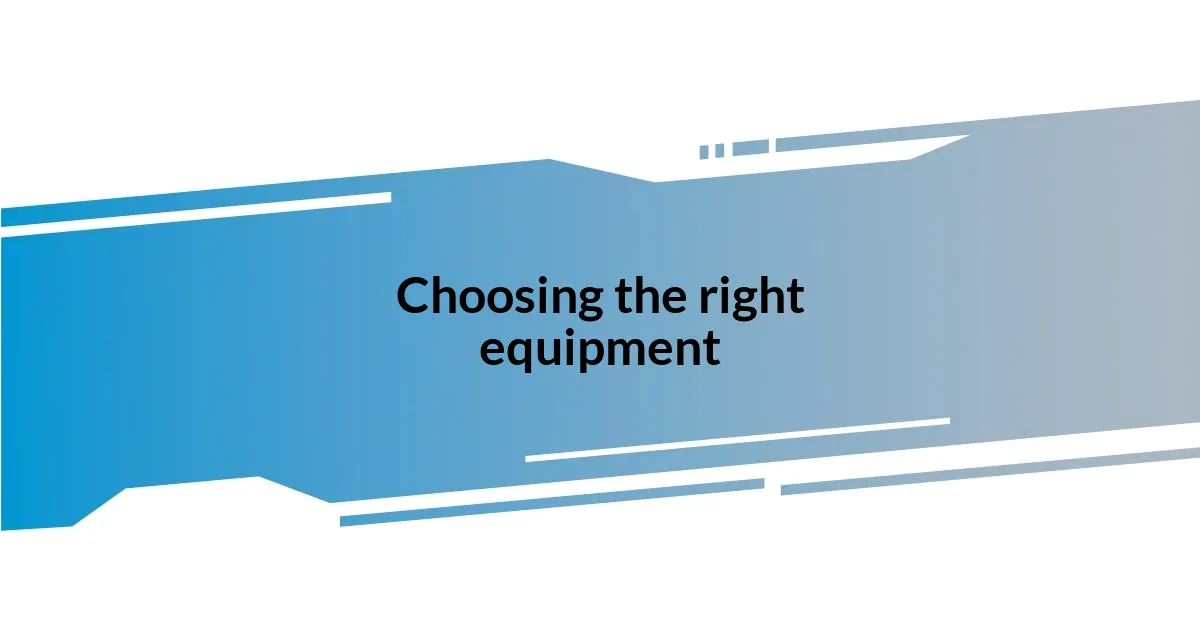
Choosing the right equipment
Choosing the right equipment for street art photography can significantly enhance your experience and results. I’ve experimented with various cameras and lenses, and I’ve found that a lightweight mirrorless camera strikes the perfect balance between portability and quality. This is critical when you’re wandering through busy streets where you might want to move quickly to catch that spontaneous moment of creativity manifesting on the wall.
When it comes to lenses, I often recommend a fast prime lens, like a 35mm or 50mm f/1.8. This choice allows for sharp images with beautiful bokeh, bringing the focus squarely on the vibrant art. I still recall the day I shot a piece that had intricate details; the bokeh effect transformed my photo into almost a painting, highlighting the artist’s strokes beautifully. It’s moments like these that remind me how vital lens choice can be in telling a deeper story through my images.
Lastly, don’t underestimate the importance of a sturdy yet compact tripod. I can’t tell you how many times I’ve struggled to stabilize my shots in low-light situations, wishing I’d had my tripod with me. Every piece of equipment tells a part of the story we’re trying to capture. With the right tools, I’ve often felt like I became part of the artwork itself, weaving through the stories on those walls, almost as if I were walking with the artist.
| Equipment | Recommended Type |
|---|---|
| Camera | Lightweight Mirrorless |
| Lens | 35mm or 50mm f/1.8 Prime |
| Tripod | Compact and Sturdy |
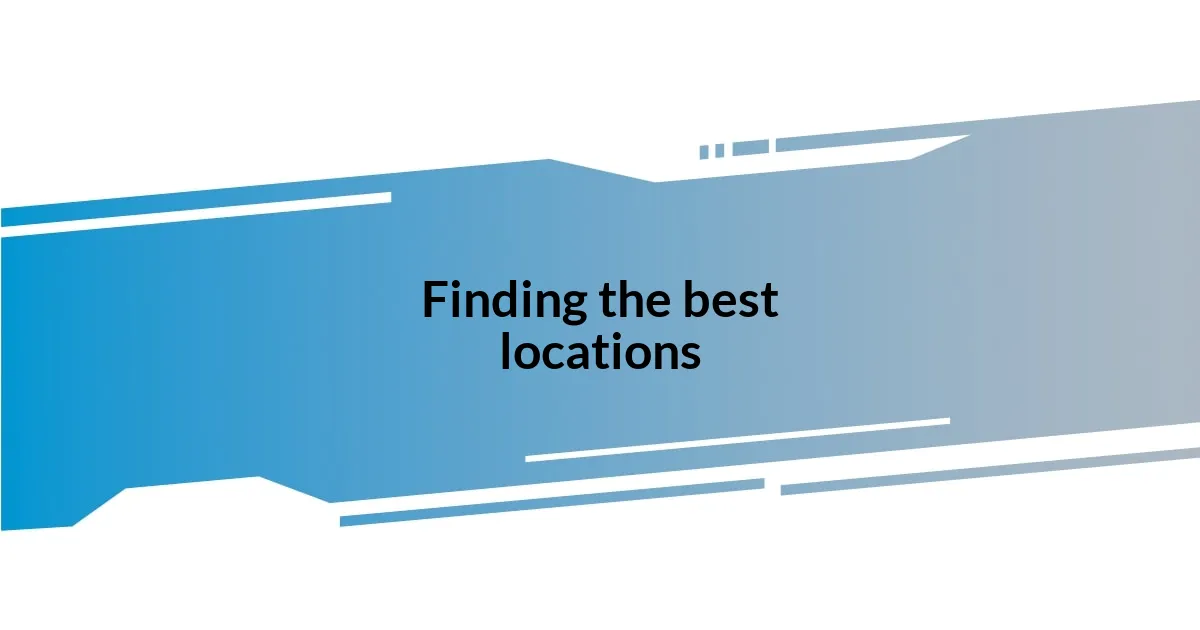
Finding the best locations
Finding the best locations for street art photography can be a fascinating adventure in itself. My personal journey took me to the unexpected corners of my city where murals seemed to breathe life. One afternoon, while wandering through a less-trodden neighborhood, I stumbled upon a stunning piece that had its own unique aura, almost as if it had been waiting just for me to discover it. I felt an ephemeral thrill in knowing that many passersby would never take the time to look beyond the surface of their daily routines.
Here are some strategies that have consistently helped me uncover those hidden locations:
- Engage with Local Communities: Connect with street art enthusiasts online. Social media and forums can reveal lesser-known hotspots.
- Scout Early or Late: Go out during off-peak hours to find art in peace, when the light is softer too.
- Explore Declining Areas: Often, abandoned buildings or neglected neighborhoods are canvassed with incredible art.
- Check Local Events: Street fairs and art festivals can lead you to new murals and inspire your creativity.
- Follow the Artists: Tracking local street artists on social media can give you insight into their latest projects and whereabouts.
Every time I find a new location, I’m reminded of the raw energy and stories waiting to be captured. It’s these moments that fuel my passion for street art photography, turning each shoot into an unforgettable exploration.
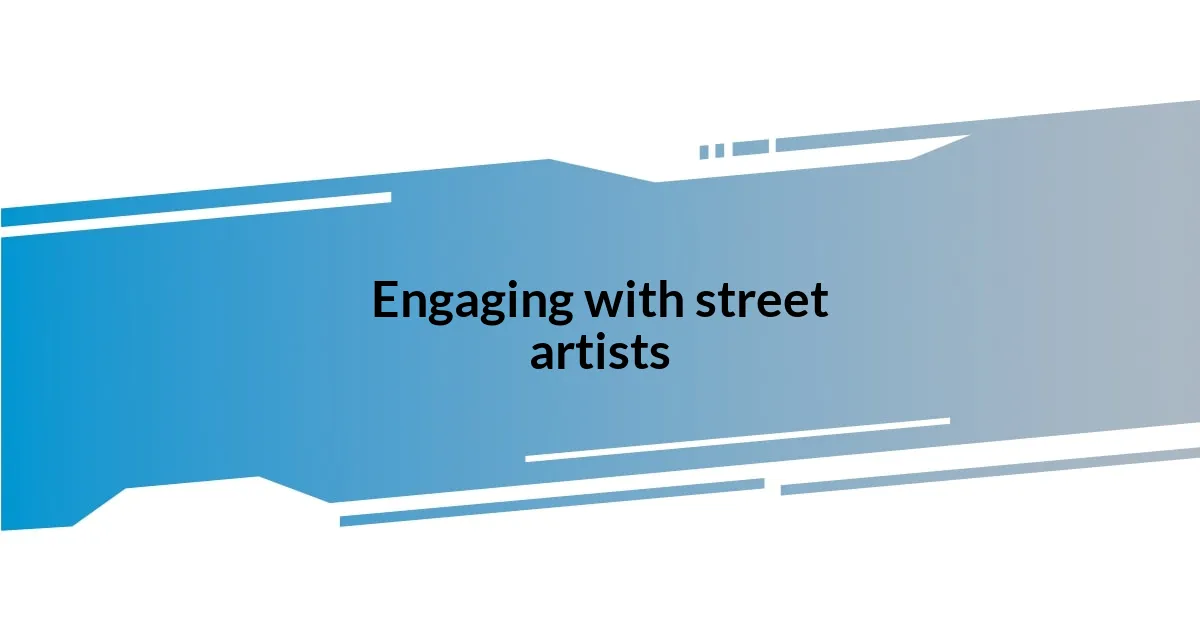
Engaging with street artists
Engaging with street artists can be one of the most rewarding aspects of street art photography. I still remember the first time I struck up a conversation with a muralist while they were working. It felt electric to hear their passion and backstory behind the piece. It really made me think—how often do we overlook the artists’ narratives while focusing solely on the artwork itself?
When I approach an artist, I try to be genuine and express my admiration for their work. One time, I complimented an artist on the bold colors they used, and we ended up chatting for over an hour about art, techniques, and inspirations. It was enlightening to see the world through their eyes. These conversations not only enhance my understanding but also foster a sense of community. I often wonder how many stories remain untold simply because we hesitate to ask.
I’ve found that building these connections usually leads to opportunities for exclusive shots and insider perspectives. Sometimes, an artist may invite you to their studio or let you in on their creative process. Those moments feel like a privilege! As I reflect on these encounters, I realize that every photo becomes richer when accompanied by a story—it’s a little bridge connecting me to the artist and their vision. So, how can we learn from each other? It starts with a simple hello.
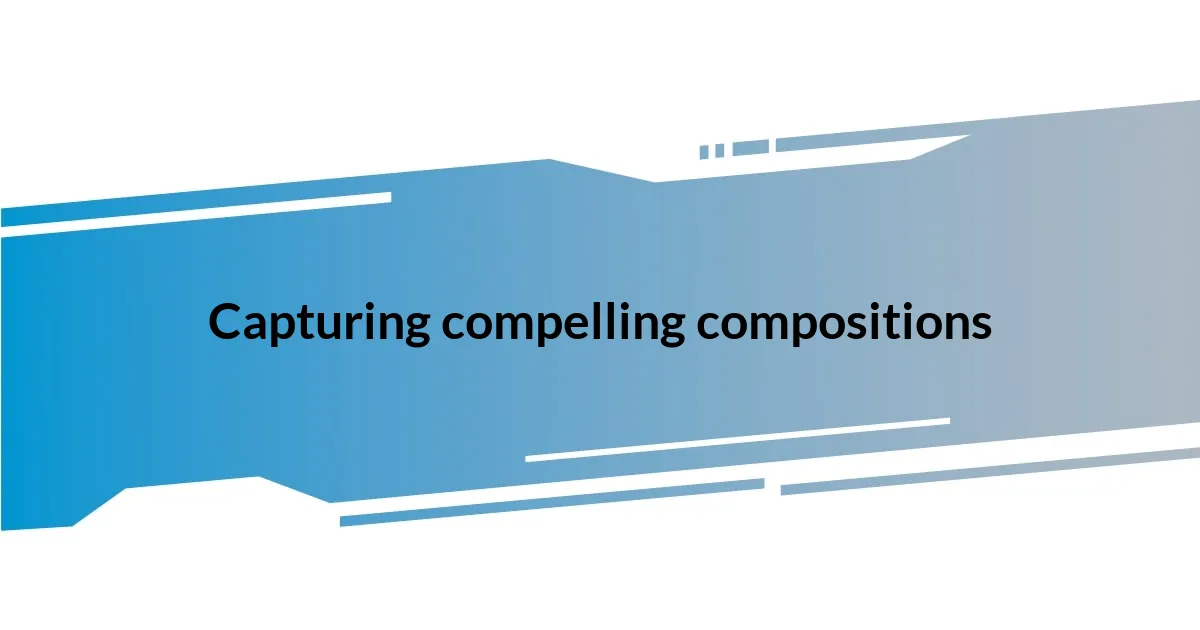
Capturing compelling compositions
Capturing compelling compositions in street art photography requires a keen eye and a little creativity. I often find that framing is everything—just a slight adjustment in angle can transform an ordinary shot into something extraordinary. For instance, during one of my outings, I positioned myself in front of a vibrant mural that echoed the city’s culture, but it wasn’t until I included a passing pedestrian that the image truly came to life. That dynamic interaction added depth and story to my photograph.
Lighting can also dictate the mood of your image. I’ve experimented with different times of day, but I’ve always favored the golden hour—those moments before sunset where the light bathes everything in a warm glow. I remember one evening, I was lucky enough to capture a mural just as the sun dipped behind the skyline. The way the colors popped against the fading light was breathtaking, almost like the artist’s vision was revealed in a magical moment. Doesn’t it make you consider how much the right light can enhance the narrative of a photo?
Lastly, don’t underestimate the power of composition techniques like leading lines or rule of thirds. I once came across a long alley adorned with art and knew I had to use the pathway to guide the viewer’s eye through my image. By aligning my shot to include those lines, I created a sense of journey and exploration. Reflecting on that moment, I wonder, how does each visual element you choose contribute to the overall story you’re telling with your photography? Every detail matters, and that’s what makes each shot feel uniquely yours.
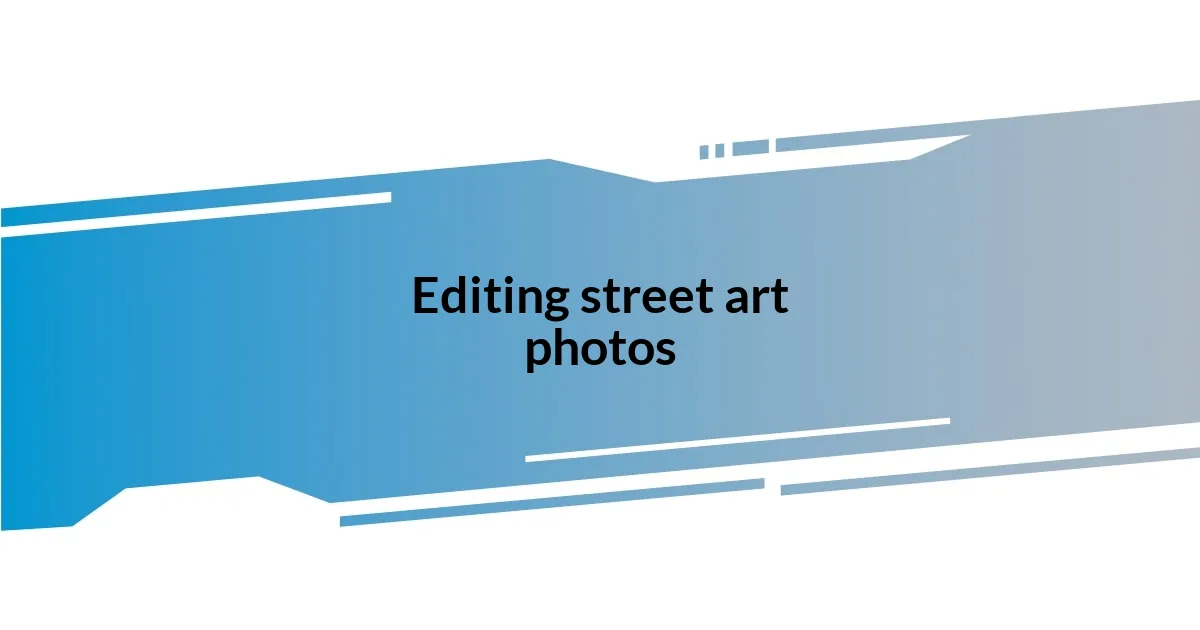
Editing street art photos
Editing street art photos can be a delightful yet daunting task. After I capture the vibrant essence of a mural, I often find myself diving into editing software to enhance those striking colors and sharpen details. One night, I spent hours tweaking a shot of a graffiti piece that originally felt flat; with just a few adjustments in saturation and contrast, it turned into a vivid explosion of color that felt true to the artist’s intent. Isn’t it thrilling how a little post-processing can breathe new life into a photograph?
I always aim to keep the editing process true to the original art while allowing my personal style to shine through. For example, I’m a fan of adding subtle grain to my images; it gives them a raw, urban feel that resonates with the gritty nature of street art. I once edited a photo of a mural layered with intricate details, and by softening the edges a bit while preserving the excitement of the piece, I felt it conveyed a sense of movement and rhythm. Who knew a single filter could encapsulate the energy of an entire intersection?
Lastly, I find that storytelling plays a pivotal role in my editing choices. When I edit, I imagine how to convey the story behind each piece effectively. I remember a moment when I paired a black-and-white edit with a pop of color on the mural itself, drawing attention to its main theme. That decision not only highlighted the artistry but also made the viewer linger a little longer. How do your editing choices shape the story you want your audience to feel? Each click of the mouse can bring forward a narrative waiting to be explored.
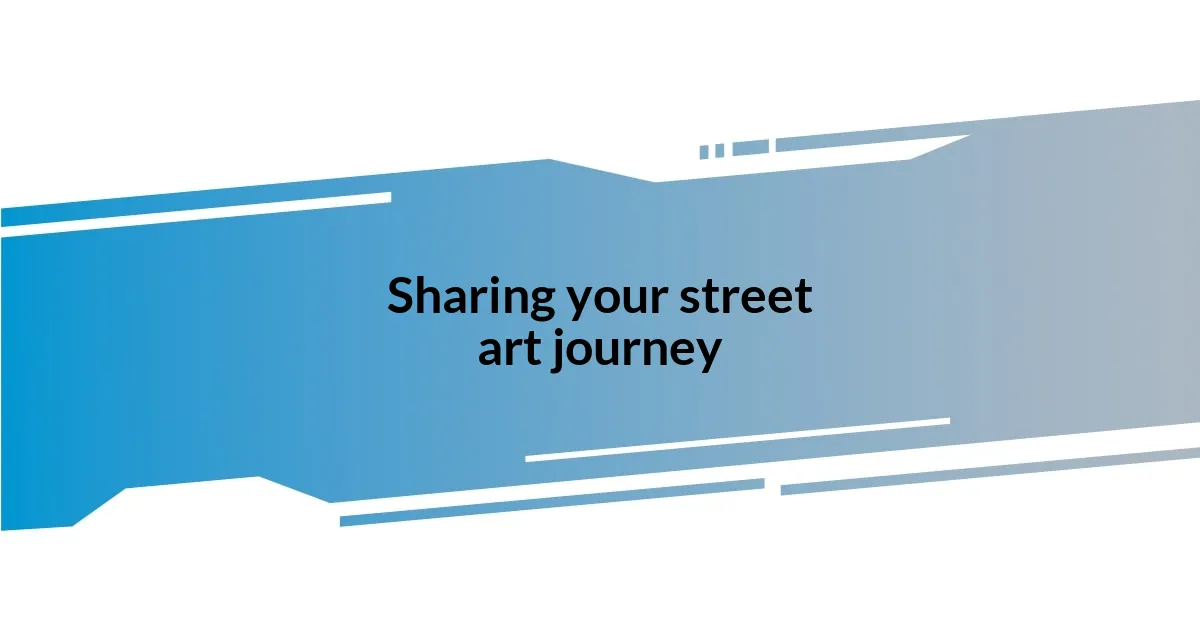
Sharing your street art journey
Sharing your street art journey can be both a fulfilling and enlightening experience. I often find myself reaching out to fellow enthusiasts through social media or local art groups, sharing not just my photographs, but the stories behind them. One time, I posted a photo of an evocative piece that spoke to me, and it sparked a wonderful discussion about the artist’s intention and the societal issues the mural addressed. It was eye-opening to see how others interpreted the same artwork differently—doesn’t it make you realize the diverse perspectives we all hold?
Creating a blog or simple photo diary can also serve as a fantastic outlet for documenting your street art adventures. I remember compiling a series of posts chronicling my explorations in a graffiti-laden neighborhood. As I reflected on each outing, I would jot down my thoughts and feelings about the art I encountered—capturing that fleeting exhilaration I felt during my discovery. These reflections not only deepen my appreciation but also create a bond with readers who share a similar passion. Have you thought about how sharing your personal insights can ignite interest among others?
Another rewarding aspect of sharing your journey is connecting with the artists themselves. One memorable experience for me was when I bravely approached a muralist while they were painting. To my delight, they welcomed me into their creative process, sharing their inspiration and methods. By sharing that encounter on my platform, I was able to bridge the gap between spectators and creators, inviting viewers to appreciate the labor and love that goes into each piece. It really made me ponder—how does building these connections shape our understanding of street art? Each interaction we have enriches the narrative we tell through our photography.